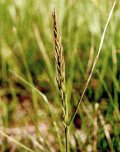
Tall fescue

| Pasture type and use | Perennial grass. Main growth in spring/summer/autumn. Dryland and irrigated primarily for grazing. Can also be used for hay and silage. |
|---|---|
| Area of adaptation | Northern and Central Tablelands and limited use in Southern Tablelands, South Coast, South West Slopes, Hunter and irrigated areas. Winter-active types have potential for use in these southern areas in particular. |
| Min. average annual rainfall |
750 mm for the summer-active types. 500 mm for summer-dormant (winter-active) varieties. |
| Advantages |
|
| Disadvantages |
|
| Soil requirements | Grows across a wide range of soil types from sandy to heavy clay soils, tolerating soil acidity, and relatively high soil aluminium (<15%) and salinity (<8 dS/m(ECe)). |
| Varieties |
Select varieties initially on the basis of plant type. Select also for seedling vigour, rust resistance and local performance (where data is available).
* Denotes that this variety is protected by Plant Breeder’s Rights. |
| Sowing rates: | |
| - as only species | 6–15 kg/ha |
| - in mixtures | 3–10 kg/ha |
| Sowing time | Autumn/early winter (March to June). In high-altitude high-rainfall Tableland districts, especially in the northern part of the state, spring sowings (August to September) can also be successful. |
| Companion species | Legumes (white, red and subterranean clovers, lucerne, lotus), and other temperate grasses (phalaris, cocksfoot, ryegrass). |
| Inoculation | N/A |
| Major nutrient deficiencies | Nitrogen, phosphorus and sulfur. |
| Main insect pests | Pasture scarabs (but is more tolerant than most other temperate grasses), redlegged earth mites, blue oat mites, field crickets, slugs and snails. |
| Main diseases | Leaf diseases (e.g. rust, blights) occasionally occur, particularly in humid summer conditions. |
| Management |
Most tall fescue cultivars exhibit poor seedling vigour, resulting in slow establishment. Consequently it is important to minimise competition from weeds or accompanying pasture species, especially ryegrass and cover crops.
Once established, keep pasture within the ‘active growth’ phase to maximise pasture growth rates and feed quality, allow rapid post-grazing recovery, and encourage companion legumes. Suggested yield limits for grazing are 800–2500 kg DM/ha, therefore necessitating some form of rotational grazing, at least during spring and summer. |
| Livestock disorders of particular note | Summer ill thrift, or winter lameness, associated with ergot alkaloids within the grass. |
| Further information |
Agnote DPI-234 New pasture grass and legume varieties.
Technical Bulletin 47, Grazing management of temperate pastures: Literature reviews and grazing guidelines for major species. Agfact P2.3.9 Endophytes of perennial ryegrass and tall fescue |
Acknowledgments
Advice on livestock health disorders was provided by Dr Chris Bourke, Principal Research Scientist, NSW Agriculture, Orange. His contribution is gratefully acknowledged.
Photo: Robert Freebairn, NSW Agriculture, Gunnedah

